databases
- The database management
- The table view
- The record view
- Import and export via clipboard
- import database
- Export database
- MySQL command prompt
The database system is used to create and edit database tables. As usual, tables and data records can be easily edited online. An import and export function is available for importing large amounts of data.
The database management
The database management can be found in the editing mode of your homepage under  DB -> Database Management .
DB -> Database Management .
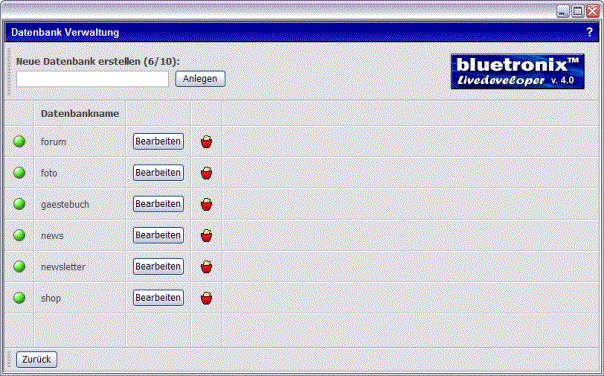
A new database table can be created in the upper part. To do this, enter the desired database name and click on Invest . In the lower part, the already existing database tables are displayed, for example the "shop" database.
To edit the table, click next to the database name To edit .
 The database tables "shop", "forum" and "guestbook" do not have to be created manually in the database administration. These are created automatically when the modules are installed. Please refer Chapter Modules .
The database tables "shop", "forum" and "guestbook" do not have to be created manually in the database administration. These are created automatically when the modules are installed. Please refer Chapter Modules .
The table view
In the table view, all data sets (50 pieces per page) are displayed in table form. With the help of the table view, several data records can be changed quickly at the same time.
In the edit mode of your home page, click  DB -> Database Management and click next to the database name, for example "shop". To edit . The data sets are loaded in the table view.
DB -> Database Management and click next to the database name, for example "shop". To edit . The data sets are loaded in the table view.

Database table view
 save database
save database
 cut out
cut out
 Copy
Copy
 Insert
Insert
 Import via clipboard
Import via clipboard
 Export via the clipboard
Export via the clipboard
 Previous page
Previous page
Page Selection (Increment 50)
 Next page
Next page  create new record
create new record  Edit record
Edit record  delete dataset
delete dataset  delete entire record list
delete entire record list  Insert Column
Insert Column  Column Settings
Column Settings  Delete Column
Delete Column  seek
seek
edit fields
Click in the desired field (the field will be outlined in red) and enter a text. To switch between fields, you can also use the cursor keys (1 2 ) use.
Delete row content, delete column content
Click on the row number on the left, for example on record number 5 (the field will be colored orange). Now press the Remove button to delete the record.
To delete a column, click on the column name (the field turns orange) and on the Remove button .
Copy row content, copy column content
Click on the line number of the line to be copied. Choose in the menu  Copy . Now click on the line number in which the content is to be inserted and select Das from the menu
Copy . Now click on the line number in which the content is to be inserted and select Das from the menu  Insert Symbol. Column contents are copied in the same way. To do this, click on the column name.
Insert Symbol. Column contents are copied in the same way. To do this, click on the column name.
Insert, delete, change column
Click on the column name after which the new column is to be inserted. Choose  Insert Column .
Insert Column .

Enter a column name and set the type. The column type defines the MySQL type and later helps to populate the database. For example, the HTML type is shown with a connection to the editor or the image type with a connection to image management. Confirm with Save on computer .
To delete the column, click the appropriate column name and click  Delete Column .
Delete Column .
To change the column settings, click on the column name and on the  Column Settings Symbol. For example, change the column name or type and save the settings.
Column Settings Symbol. For example, change the column name or type and save the settings.
 Inserting, deleting and changing columns can mean that modules such as shop, forum, guest book etc. no longer run correctly. Don't just change the column names in the shop, as further adjustments to the PHP code of the shop pages are necessary.
Inserting, deleting and changing columns can mean that modules such as shop, forum, guest book etc. no longer run correctly. Don't just change the column names in the shop, as further adjustments to the PHP code of the shop pages are necessary.
Edit record
The data records can be changed in the table view. The data record view is better suited for larger texts and for using the fill-in functions. To do this, click on a data record and on that  Edit record Symbol.
Edit record Symbol.
The record view
The data record view shows all columns of a data record on one page in a clear form.

To fill out a field, click in the corresponding field and enter a text. With the Tab key you can simply move to the next field.
 save database
save database
 cut out
cut out
 Copy
Copy
 Insert
Insert
 previous record
previous record
Record selection – enter the record number here to select a specific record
to change
 next record
next record
 seek
seek
The ID increments by one option causes the ID to increase by 1 when the next data set is selected
will. Without this option, the next record found is displayed.
 Editor – fill-in help for type HTML, switches to the HTML editor for the field
Editor – fill-in help for type HTML, switches to the HTML editor for the field  Image management – Fill-in help for type images, switches to image management
Image management – Fill-in help for type images, switches to image management  Document management – Fill-in help for type document, switches to document management
Document management – Fill-in help for type document, switches to document management  Link – Fill-in help for type Link, opens the Link window
Link – Fill-in help for type Link, opens the Link window
Import and export via clipboard
Importing and exporting via the clipboard is a useful tool for copying data sets to and from other programs. In this example, some data records are to be copied to Excel via the clipboard.
To do this, open  DB -> Database Management and click next to the database name "shop". To edit .
DB -> Database Management and click next to the database name "shop". To edit .
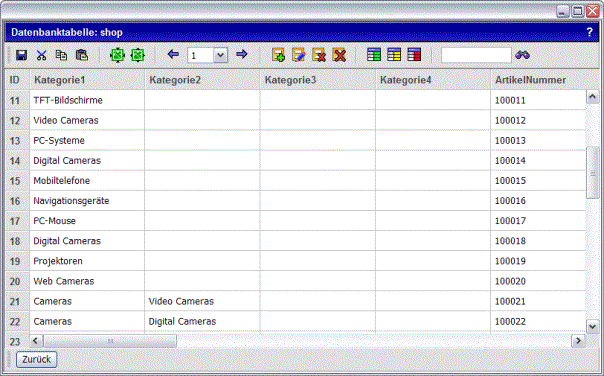
Now click that  export Symbol. Start Excel and click on the menu Edit -> Paste . The content, for example prices and descriptions, can now be changed in Excel.
export Symbol. Start Excel and click on the menu Edit -> Paste . The content, for example prices and descriptions, can now be changed in Excel.
 The import and export via the clipboard always copies only the data records that are displayed in the table view (50 pieces). If you want to import or export more than 50 records, the chapter import database or. Export database helpful.
The import and export via the clipboard always copies only the data records that are displayed in the table view (50 pieces). If you want to import or export more than 50 records, the chapter import database or. Export database helpful.
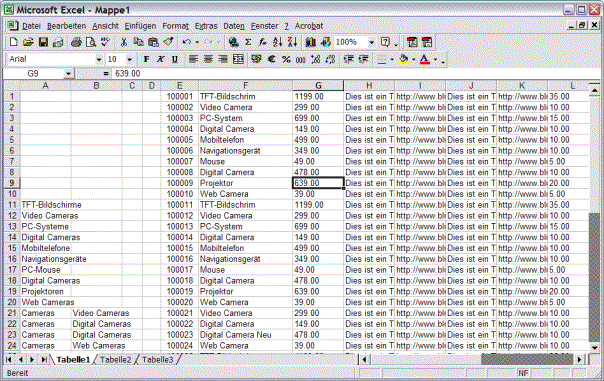
To import the changed data, select all rows (max. 50) and all columns in Excel (for the "shop" database, these are 19 columns, in Excel up to column "S"). Click on the menu Edit -> Copy . Switch to the bluetronix software and click on in the table view  Import Symbol. Save the database table with one click
Import Symbol. Save the database table with one click  Save on computer .
Save on computer .
 Always enter the URLs for images, links and documents with the complete URL. For example http://www.bluetronix-demo.de/Bilder/Article_1.jpg. Do not use spaces, umlauts or special characters in the URL. Allowed are aZ, 0-9, as well as the characters '_', '-', '.'.
Always enter the URLs for images, links and documents with the complete URL. For example http://www.bluetronix-demo.de/Bilder/Article_1.jpg. Do not use spaces, umlauts or special characters in the URL. Allowed are aZ, 0-9, as well as the characters '_', '-', '.'.
import database
With the import function, large amounts of data can be conveniently imported into the database. Files in CSV and TXT format can be imported.
 It is important for the import that the columns in the import file match those in the database. To do this, compare the table headers in the table view with the columns in the Excel file. Even if columns do not contain any values, they must be included for the import.
It is important for the import that the columns in the import file match those in the database. To do this, compare the table headers in the table view with the columns in the Excel file. Even if columns do not contain any values, they must be included for the import.
In the following example, an item file is to be imported from Excel into the shop database. The columns have been adjusted in Excel to match the columns in the database. The header with the column names has been deleted.
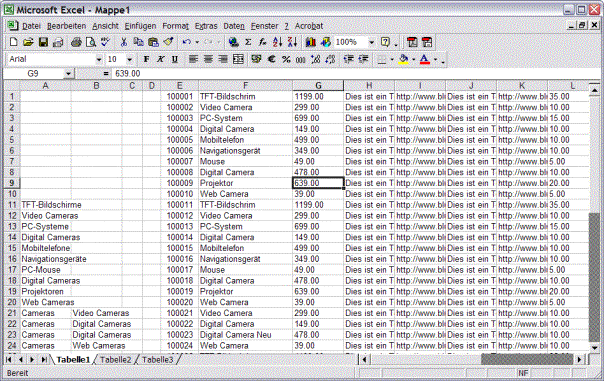
Step 1 - Save file in Excel as CSV
In Excel, click File -> Save As , enter a file name and select as file type CSV (comma separated *.csv) . click on Save on computer . Confirm any information with OK and YES .
Step 2 - Import the file in the database manager
Start in editing mode on your homepage  DB -> Database Import .
DB -> Database Import .
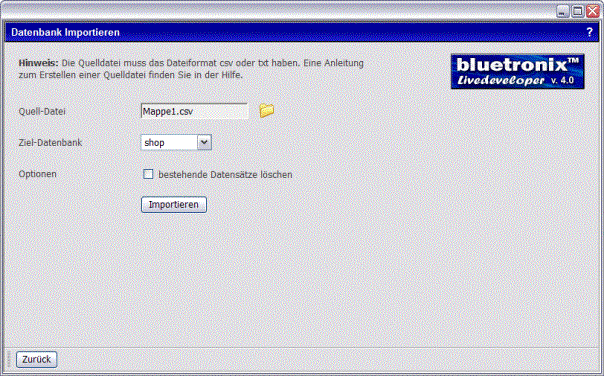
Click on the icon  document management . Click to upload the import file Search , select the appropriate file on your local PC and click on Open . Start uploading by clicking Upload file .
document management . Click to upload the import file Search , select the appropriate file on your local PC and click on Open . Start uploading by clicking Upload file .
Now select the file (by clicking on the file name) and click on Insert File .
Now specify the target database (in our example, the "shop" database). The "Delete existing data records" option causes all existing data records to be deleted before the import. If this option remains empty, the data records to be imported will be added to the existing ones.
Click to start the import Import . Depending on the amount of data, the import can take a few minutes. After the import is complete, you can control the action in the table view. The import of a TXT file works in the same way.
Export database
With the help of this function, large amounts of data can be exported in CSV or TXT format.
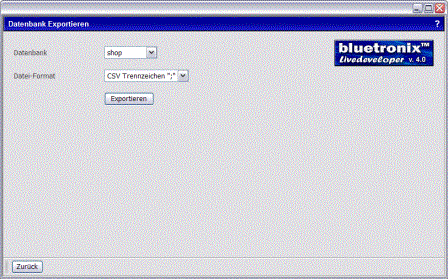
Open your homepage in edit mode  DB -> Database Export . Select the desired database from the list and specify the file format (e.g. CSV). click on Export . Confirm the message window with OK . After the export is complete, click now Save file to save the file to your local PC. In the file window, click Save on computer .
DB -> Database Export . Select the desired database from the list and specify the file format (e.g. CSV). click on Export . Confirm the message window with OK . After the export is complete, click now Save file to save the file to your local PC. In the file window, click Save on computer .
Start Excel and select File -> Open . Select as file type Text files (*.csv) . In the file window, click your file (it will be grayed out) and click Open . The file is then loaded into Excel.
MySQL command prompt
The MySQL command prompt allows advanced users to perform actions on records in addition to the table and record view functionality. For example, to specifically delete several data records that meet a certain condition, etc. You can find the function in the edit mode on your homepage under  DB -> MySQL command prompt . You can find more information about MySQL on the Internet under the keyword MySQL.
DB -> MySQL command prompt . You can find more information about MySQL on the Internet under the keyword MySQL.